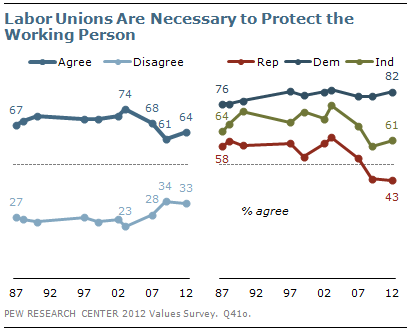Scott Walker avoided a recall last night in what was in large part a union-driven initiative to remove him from office. Perhaps worrisome, 36% of voters from union households voted for Scott Walker in the recall. The outcome of this election will doubtlessly fuel more discussion about unionization and the future of organized labor, and that discussion tends to be fairly negative.
The central feature of commentary about the state of organized labor is the union density rate. Union density is hovering at around 12%, which is down from its historical peak of around 40%. Although this number is alarming for a number of reasons, I do not think it is as informative as people make it out to be. While official unions have declined, there are a number of other worker organizations that have sprung up.
In just the last few years, we have seen the creation and explosion of worker centers, a new type of worker organization that caters to those who are unable to access traditional unions. Expansive networks of non-unionized workers have formed around certain kinds of work and identities. For example, there is the National Day Laborer Organizing Network, the National Domestic Workers Alliance, the National Guestworker Alliance, and the Coalition of Immokalee Workers, just to name a few. There are also large community organizations like Jobs with Justice and Interfaith Worker Justice, which bring together community support for union and non-union worker struggles. Finally, there is Working America, a massive 3 million person organization made up non-union members that rallies political and electoral support for union-friendly and worker-friendly causes.
It is hard to know how many people are involved in these types of organizations, but it is probably a pretty substantial number once you add it all up. These folks represent a significant chunk of the modern-day labor movement, even though they do not get counted in the union density statistics. One of the reasons these types of organizations have proliferated is because unionization has become such a perilous venture. Pro-union workers are regularly fired during union campaigns, companies threaten to shut down businesses if workers vote for a union, and then companies break every labor law on the book to keep the union out. As a result, unionizing under the law is exceedingly difficult if an option at all.
Importantly however, the decline of unionization has not marched lockstep with a decline in public opinion towards unions. Although down, 64% of Americans still believe that unions are necessary to protect working people, with even 43% of Republicans saying so.

This support for unions is not a carry-over from a prior era either. Pew surveys have consistently shown a substantially larger level of support for unions among those aged 18-29. The belief that organized labor is necessary and that unions are important is a majoritarian belief in the United States, and younger people believe it the most.
The real difficulty is not convincing people of the importance of unions: most people already realize their importance. It is somehow making unionization a serious possibility again. For those in Right to Work states, and even those in other states, it is just incredibly difficult to establish a union at a new workplace. The level of intimidation from companies is just too high. There are legislative ways to counteract some of this coercive company behavior (the Employee Free Choice Act for instance), but such changes do not seem to be high enough on anyone’s priority list to become a reality anytime soon.
So, there is some promise in the future of the labor movement despite how grim things are usually presented. A large base of support for organized labor is out there, and a large sector of informal labor organization has been building up even as official unionization rates fall. It is hard to know what the future labor movement will look like, but it is even harder to imagine it going away altogether. Those who predict its annihilation seem to be participating in wishful thinking, or are simply unaware of the non-union developments within the labor movement in the last couple of decades.